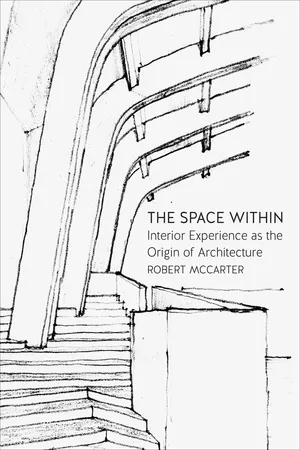
- English
- ePUB (mobile friendly)
- Available on iOS & Android
About this book
Alvar Aalto once argued that what mattered in architecture wasn't what a building looks like on the day it opens but what it is like to live inside it thirty years later. In this book, architect and critic Robert McCarter persuasively argues that interior spatial experience is the necessary starting point for design, and the quality of that experience is the only appropriate means of evaluating a work after it has been built.
McCarter reveals that we can't really know a piece of architecture without inhabiting its spaces, and we need to counter our contemporary obsession with exterior views and forms with a renewed appreciation for interiors. He explores how interior space has been integral to the development of modern architecture from the late 1800s to today, and he examines how architects have engaged interior space and its experiences in their design processes, fundamentally transforming traditional approaches to composition. Eloquently placing us within a host of interior spaces, he opens up new ways of thinking about architecture and what its goals are and should be.
Frequently asked questions
- Essential is ideal for learners and professionals who enjoy exploring a wide range of subjects. Access the Essential Library with 800,000+ trusted titles and best-sellers across business, personal growth, and the humanities. Includes unlimited reading time and Standard Read Aloud voice.
- Complete: Perfect for advanced learners and researchers needing full, unrestricted access. Unlock 1.4M+ books across hundreds of subjects, including academic and specialized titles. The Complete Plan also includes advanced features like Premium Read Aloud and Research Assistant.
Please note we cannot support devices running on iOS 13 and Android 7 or earlier. Learn more about using the app.
Information
References
Table of contents
- Front Cover
- Half Title
- Title Page
- Copyright
- Contents
- Introduction: The Primacy of Interior Experience in Architecture
- one The Space Within as the Origin of Architecture
- two The Nearness of Interior Experience and the Distance of Exterior Form
- three Three Early Modern Conceptions of Interior Space
- four The Separate Paths of the Eye and the Body in Experience
- five The Shape of Interior Space and the Boundary of Place
- six The Society of Spaces and the Emplacement of Encounters
- seven The Nesting of Places at Once Intimate and Immense
- eight Making Room for Experience and Memory
- nine Interior Experience of the Exterior Environment
- Conclusion: Interior Experience as Initiation and Evaluation of Architecture
- References
- Bibliography
- Acknowledgements
- Index